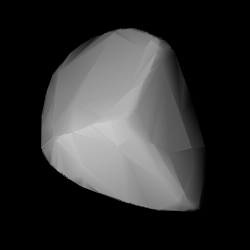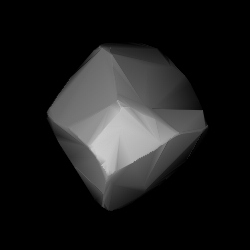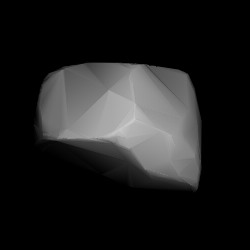460 Scania is a background asteroid and a slow rotator from the central regions of the asteroid belt. It was discovered by German astronomer Max Wolf at the Heidelberg-Königstuhl State Observatory on 22 October 1900. The uncommon K-type asteroid has an exceptionally long rotation period of 164.1 hours and measures approximately 21 kilometers in diameter. It was named after the Swedish region of Scania, where a meeting was held by the Astronomische Gesellschaft in 1904.
716 Berkeley is a background asteroid from the central regions of the asteroid belt. It was discovered by Austrian astronomer Johann Palisa at the Vienna Observatory on 30 July 1911. The stony S-type asteroid has a rotation period of 15.6 hours and measures approximately 21 kilometers in diameter. It was named after the city of Berkeley, California, where the discoverer's colleague Armin Otto Leuschner (1868–1953) was the director of the local observatory.
717 Wisibada is a dark background asteroid from the outer regions of the asteroid belt. It was discovered on 26 August 1911, by German astronomer Franz Kaiser at the Heidelberg-Königstuhl State Observatory in southwest Germany. The D-type asteroid measures approximately 29 kilometers in diameter with no rotation period yet determined. It was named after the discoverer's birthplace, the city of Wiesbaden in Hesse, Germany.

722 Frieda is a bright background asteroid and slow rotator from the inner regions of the asteroid belt. It was discovered by Austrian astronomer Johann Palisa at the Vienna Observatory on 18 October 1911. The stony S-type asteroid has a notably long rotation period of 131.1 hours and measures approximately 9 kilometers in diameter. It was named after Frieda Hillebrand, daughter of Austrian astronomer Karl Hillebrand (1861–1939), and grand-daughter of Edmund Weiss (1837–1917) who had been the director of the discovering observatory.
745 Mauritia is a dark background asteroid from the outer regions of the asteroid belt, approximately 24 kilometers in diameter. It was discovered on 1 March 1913, by German astronomer Franz Kaiser at the Heidelberg-Königstuhl State Observatory in Germany. The presumed carbonaceous C-type asteroid has a rotation period of 9.9 hours. It was named after Saint Maurice, patron of the Saint Mauritius church in the city of Wiesbaden, where the discoverer was born.

748 Simeïsa is a very large Hilda asteroid from the outermost regions of the asteroid belt, approximately 104 kilometers in diameter. It was discovered on 14 March 1913, by Russian astronomer Grigory Neujmin at the Simeiz Observatory on the Crimean peninsula. The dark P-type asteroid has a rotation period of 11.9 hours and a shape that is reminiscent of a tetrahedron. It was the first asteroid discovery made in Russia and named after the discovering observatory and its nearby Crimean town, Simeiz.
783 Nora is a dark background asteroid from the inner regions of the asteroid belt. It was discovered by Austrian astronomer Johann Palisa at the Vienna Observatory on 18 March 1914. The carbonaceous C-type asteroid has a longer-than average rotation period of 55.5 hours and measures approximately 40 kilometers in diameter. It was likely named after Nora Helmer, principal character in the play A Doll's House by Norwegian poet Henrik Ibsen.
786 Bredichina is a carbonaceous and very large background asteroid, approximately 104 kilometers in diameter, located in the outer region of the asteroid belt. It was discovered by German astronomer Franz Kaiser at the Heidelberg-Königstuhl State Observatory on 20 April 1914. The elongated C-type asteroid has a longer than average rotation period of 29.4 hours. It was named after Russian astronomer Fyodor Bredikhin (1831–1904).
794 Irenaea is a dark background asteroid from the outer regions of the asteroid belt. It was discovered on 27 August 1914, by Austrian astronomer Johann Palisa at the Vienna Observatory. The presumed C-type asteroid has a rotation period of 9.1 hours and measures approximately 36 kilometers in diameter. It was likely named after Irene Hillebrand, daughter of Austrian astronomer Edmund Weiss (1837–1917).
866 Fatme is a large background asteroid, approximately 86 kilometers in diameter, located in the outer region of the asteroid belt. It was discovered by German astronomer Max Wolf at the Heidelberg-Königstuhl State Observatory on 25 February 1917. The X-type asteroid has a short rotation period of 5.8 hours. It was named after "Fatme", a character in the opera Abu Hassan by Carl Maria von Weber (1786–1826).
1018 Arnolda, provisional designation 1924 QM, is a stony asteroid from the central regions of the asteroid belt, approximately 16 kilometers in diameter. It was discovered on 3 March 1924, by German astronomer Karl Reinmuth at the Heidelberg-Königstuhl State Observatory in southwest Germany. The asteroid was named after physicist Arnold Berliner.
1113 Katja, provisional designation 1928 QC, is a background asteroid from the outer regions of the asteroid belt, approximately 39 kilometers in diameter. It was discovered by Pelageya Shajn at the Simeiz Observatory in 1928, and named after Ekaterina Iosko, a staff member at the discovering observatory.
1194 Aletta, provisional designation 1931 JG, is a carbonaceous asteroid from the outer region of the asteroid belt, approximately 55 kilometers in diameter. It was discovered on 13 May 1931, by South African astronomer Cyril Jackson at Johannesburg Observatory in South Africa. It was later named after the discoverer's wife Aletta Jackson.

1555 Dejan, provisional designation 1941 SA, is an asteroid from the background population of the central regions of the asteroid belt, approximately 22 kilometers in diameter. It was discovered on 15 September 1941, by Belgian astronomer Fernand Rigaux at the Royal Observatory of Belgium in Uccle. The asteroid was named after Dejan Đurković, son of Serbian astronomer Petar Đurković.

1274 Delportia, provisional designation 1932 WC, is a stony Florian asteroid from the inner regions of the asteroid belt, approximately 10 kilometers in diameter. It was discovered on 28 November 1932, by Belgian astronomer Eugène Delporte at Uccle Observatory in Belgium. It was named after the discoverer himself.

1277 Dolores is a carbonaceous background asteroid from the central regions of the asteroid belt, approximately 27 kilometers in diameter. It was discovered on 18 April 1933, by Soviet astronomer Grigory Neujmin at the Simeiz Observatory on the Crimean peninsula. The asteroid was named after Spanish communist Dolores Ibárruri.
1421 Esperanto, provisional designation 1936 FQ, is a dark background asteroid from the outer regions of the asteroid belt, approximately 55 kilometers in diameter. It was discovered on 18 March 1936, by Finnish astronomer Yrjö Väisälä at the Iso-Heikkilä Observatory in Turku, southwest Finland. The presumed C-type asteroid has a rotation period of nearly 22 hours. It was named for the artificial language Esperanto.

1283 Komsomolia is a metallic background asteroid and potentially slow rotator from the outer regions of the asteroid belt. Discovered by Vladimir Albitsky in 1925, it was later named after Komsomol, a political youth organization of the former Soviet Union. The M-type asteroid has roughly a rotation period 96 hours of and measures approximately 30 kilometers in diameter.
1989 Tatry, provisional designation 1955 FG, is a carbonaceous Vestian asteroid and tumbling slow rotator from the inner regions of the asteroid belt, approximately 16 kilometers in diameter.

1236 Thaïs is a dark background asteroid from the inner regions of the asteroid belt. The rare T-type asteroid has a notably long rotation period of 72 hours and measures approximately 18 kilometers. It was discovered on 6 November 1931, by Soviet astronomer Grigory Neujmin at Simeiz Observatory on the Crimean peninsula, and named after the ancient Greek prostitute Thaïs.








